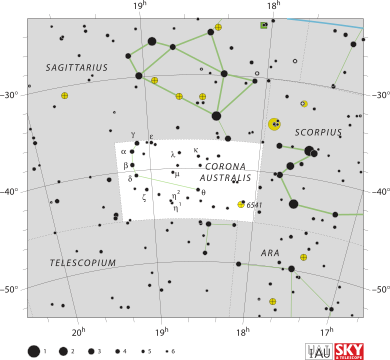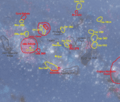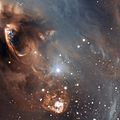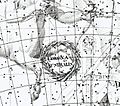Corona Australis facts for kids
| Constellation | |

List of stars in Corona Australis
|
|
| Abbreviation | CrA |
|---|---|
| Genitive |
|
| Pronunciation | or genitive |
| Symbolism | The Southern Crown |
| Right ascension | 17h 58m 30.1113s–19h 19m 04.7136s |
| Declination | -36.7785645°–-45.5163460° |
| Area | 128 sq. deg. (80th) |
| Main stars | 6 |
| Bayer/Flamsteed stars |
14 |
| Stars with planets | 2 |
| Stars brighter than 3.00m | 0 |
| Stars within 10.00 pc (32.62 ly) | 0 |
| Brightest star | α CrA (4.10m) |
| Messier objects | 0 |
| Meteor showers | Corona Australids |
| Bordering constellations |
|
| Visible at latitudes between +40° and −90°. Best visible at 21:00 (9 p.m.) during the month of August. |
|
Corona Australis or Corona Austrina is a constellation. Its name means "southern crown", and it contrasts with Corona Borealis, the northern crown. Corona Australis was one of the 48 constellations listed by the 2nd century astronomer Ptolemy, and it remains one of the 88 modern constellations.
The Ancient Greeks saw Corona Australis as a wreath rather than a crown, and associated it with Sagittarius or Centaurus. Alpha and Beta Coronae Australis are the two brightest stars with an apparent magnitude of around 4.1. Although not a bright constellation, it is distinctive in appearance. It contains one of the closest star forming regions.
Characteristics
Corona Australis is a small constellation bordered by Sagittarius to the north, Scorpius to the west, Telescopium to the south, and Ara to the southwest. The recommended three-letter abbreviation for the constellation, as adopted by the International Astronomical Union in 1922, is 'CrA'. It cannot be seen from the British Isles as it lies too far south, but can be seen from southern Europe and the southern United States.
Notable features
Not a bright constellation, Corona Australis is nonetheless distinctive due to its easily identifiable pattern of stars. Some of the more prominent double stars include Gamma Coronae Australis - a pair of yellowish white stars 58 light years away which orbit each other every 122 years.
R Coronae Australis is an irregular variable star. Blue-white. A very young star, it is still accumulating interstellar material. It is obscured by, and illuminates, a surrounding nebula, NGC 6729, which brightens and darkens with it.
NGC 6729, NGC 6726 and 6727, and IC 4812 all make up the Corona Australis Nebula, a dusty dark nebula which is an active star forming region, containing Herbig–Haro objects (protostars). Located about 430 light years (130 parsecs) away, it is one of the closest star forming regions to our solar system.
NGC 6541 is a globular cluster. Of around 7th magnitude, it is visible in binoculars and is located around 22000 light years away.
Corona Australis also harbours RX J1856.5-3754, an isolated neutron star that is one of the closest to the earth at approximately 200 light years and suspected to be a strange star.
Images for kids
-
A starchart of night sky towards the Galactic Central area, with the Corona Australis Molecular Cloud at the bottom left marked green.
-
Close up on the Orion Arm, with major stellar associations (yellow), nebulae (red) and dark nebulae (grey) around the Local Bubble, with the Corona Australis Molecular Cloud marked below the middle.
-
Corona Australis depicted in the Atlas Coelestis of John Flamsteed
See also
 In Spanish: Corona Australis para niños
In Spanish: Corona Australis para niños







